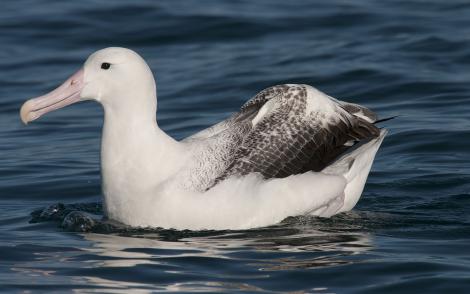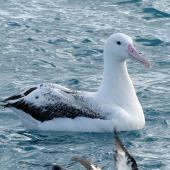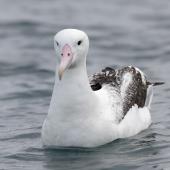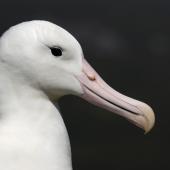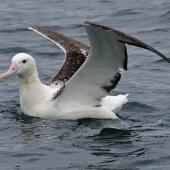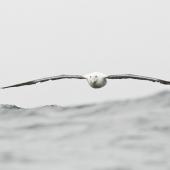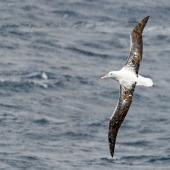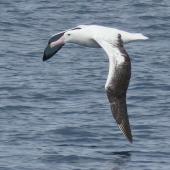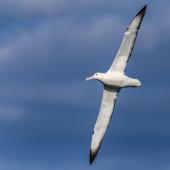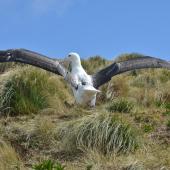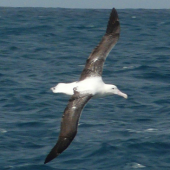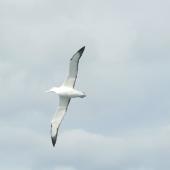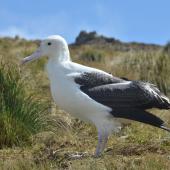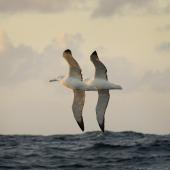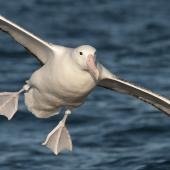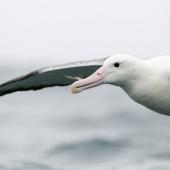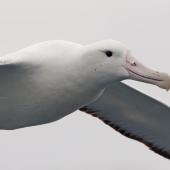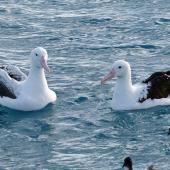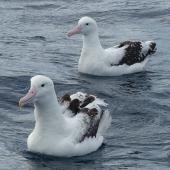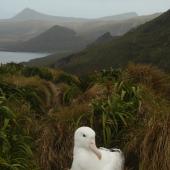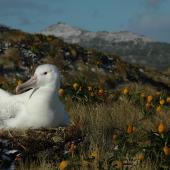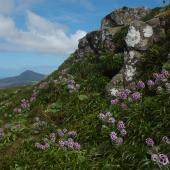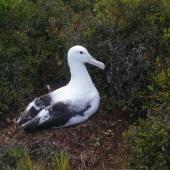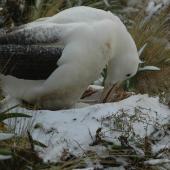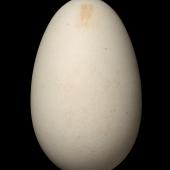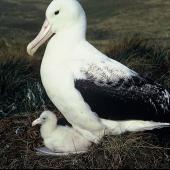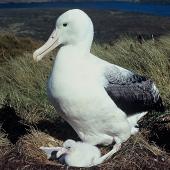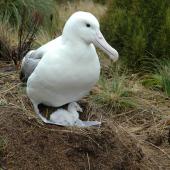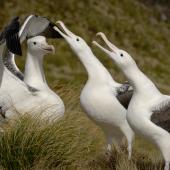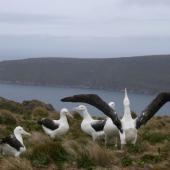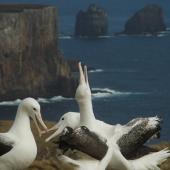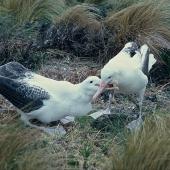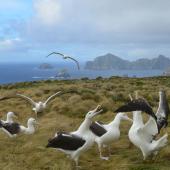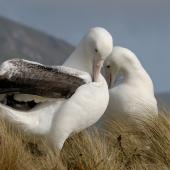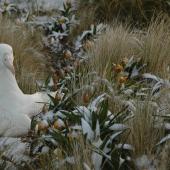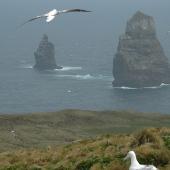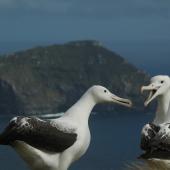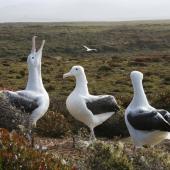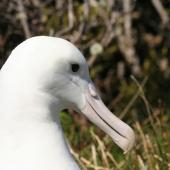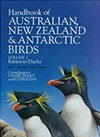Southern royal albatross | Toroa
Diomedea epomophora Lesson, 1825
Order: Procellariiformes
Family: Diomedeidae
New Zealand status: Endemic
Conservation status: Nationally Vulnerable
Other names: royal albatross
Geographical variation: Nil
The southern royal albatross (toroa) is one of the great albatross species, with a wing-span in excess of 3 m and weighing approximately 9 kg. Endemic to New Zealand, the majority of the southern royal breeding population is found on subantarctic Campbell Island, with smaller numbers on the Auckland Islands. Birds breed biennially as it takes nearly a year to rear the single chick. Non-breeding birds and juveniles cross the Southern Ocean to feed in South American waters before returning to the breeding areas by circumnavigating the globe. Young birds begin returning to the islands at 3-4 years of age to find mates, and generally start breeding at 6-12 years, and live into their 40s. Southern royals are closely related to the northern royal albatross, which breeds at Taiaroa Head and the Chatham Islands.
Identification
The southern royal albatross is the largest of the albatrosses, rivalled only by the true wandering albatross. It has a white body and black wings and white tail. The leading edge of the inner upper wing becomes whiter with age, especially in males. The robust bill is light pink with a creamy tip and with a black cutting edge to the upper mandible. Juveniles have blacker wings than adults and white bodies with black flecking on the back, flanks, crown and tail.
Voice: the ‘sky-call’, a high-pitched screaming bray, is given during displays by socializing birds (courting birds, breeders and gatherings of immature birds known as ‘gams’). Displays may culminate in yapping or clucking.
Similar species: northern royal albatrosses have a solid black upper wing, and a dark fore-carpal on the underwing also is distinctive. Juvenile northern royal albatrosses have a greater amount of black flecking dorsally. Wandering albatrosses (D. exulans) have a pinker bill and no black cutting edge. The wings of wandering albatrosses also whiten with age, but from the centre of the wing, rather than the leading edge.
Distribution and habitat
Over 99% of the southern royal albatross population breeds on Campbell Island, and a small proportion on the Auckland Islands (Enderby, Adams and Auckland), with a few birds apparently hybridising with northern royal albatrosses at Taiaroa Head. On Campbell Island, nests are scattered amongst tussock grasslands and megaherb fields at mid-elevation (180-350 m). Birds forage over the continental shelf and inner slope of southern New Zealand and the Campbell plateau, southern Chile, Uruguay and Argentina where they scavenge for squid and fish.
Population
Approximately 8500 pairs of southern royal albatross breed each year on Campbell Island and <100 pairs on the Auckland Islands.
Threats and conservation
Southern royal albatrosses on Enderby Island were extirpated by humans in the 1800s and on Campbell Island the population was severely depleted during the sheep farming era (1890-1931) by burning of vegetation, grazing, degradation of nesting habitat and direct predation of birds by people, and probably farm dogs. Once the islands were protected in the 1950s-60s, introduced mammals were gradually removed from the islands. The population recovered during the second half of the 20th Century but appears to have levelled off during the early 2000s. Southern royal albatrosses are vulnerable to fisheries bycatch in New Zealand and South American waters, as well as in transit between these areas.
Breeding
Southern royal albatrosses are monogamous, with long-term partnerships, although a small proportion divorce. Birds mature at 6-12 years of age. The breeding pattern is biennial, and successful breeders take one year off between breeding attempts. A single egg is laid in November-December, chicks hatch in February and fledge in October. Both adults of a pair share incubation and rearing. Nests on Campbell Island are dispersed at 3.1 nests/ha, although occasionally they are only a few metres apart.
Behaviour and ecology
Southern royal albatrosses are generally solitary at sea. Young birds gather to display in gams on the breeding grounds. A variety of postures and calls are used in agonistic and sexual displays, including aggressive bill snapping, clapping and gulping. Gamming and pair displays include: sky-calling with wings outstretched and head and neck stretched upward, croaking, yapping, billing, head shaking and whining. Partners mutual preen at the nest.
Food
Southern royal albatrosses scavenge post-spawning cephalopods (squid and pelagic octopuses), fish, crustaceans and salps. Food is mostly seized from the water’s surface, or by shallow plunges beneath the surface.
Websites
http://fs.fish.govt.nz/Page.aspx?pk=37&dk=4&sc=XRA
References
Moore, P.J.; Bettany, S.M. 2005. Band recoveries of southern royal albatrosses (Diomedea epomophora) from Campbell Island, 1943-2003. Notornis 52: 195-205
Moore, P.J.; Larsen, E.J.; Charteris, M.; Pryde, M., 2012. Southern royal albatross on Campbell Island/Motu Ihupuku – solving a band injury problem and population survey, 2004–2008. DOC Research and Development Series 333. Department of Conservation, Wellington.
Recommended citation
Moore, P.J. 2013 [updated 2022]. Southern royal albatross | toroa. In Miskelly, C.M. (ed.) New Zealand Birds Online. www.nzbirdsonline.org.nz
Southern royal albatross | Toroa
- Social structure
- monogamous
- Breeding season
-
- Jul
- Aug
- Sep
- Oct
- Nov
- Dec
- Jan
- Feb
- Mar
- Apr
- May
- Jun
- Nest type
- raised platform
- Nest description
- A circular mound of vegetation maintained during the season by adding new material.
- Nest height (min)
- 0.08 m
- Nest height (max)
- 0.3 m
- Maximum number of successful broods
- 1
- Clutch size (mean)
- 1
- Mean egg dimensions (length)
- 126.5 mm
- Mean egg dimensions (width)
- 78.5 mm
- Egg colour
- Creamy white
- Egg laying dates
-
- Jul
- Aug
- Sep
- Oct
- Nov
- Dec
- Jan
- Feb
- Mar
- Apr
- May
- Jun
- Interval between eggs in a clutch
- Not applicable days
- Incubation behaviour
- shared
- Incubation length (mean)
- 79 days
- Nestling type
- altricial
- Nestling period (mean)
- 241 days
- Nestling period (min)
- 224 days
- Nestling period (max)
- 253 days
- Age at fledging (mean)
- 241 days
- Age at fledging (min)
- 224 days
- Age at fledging (max)
- 253 days
- Age at independence (mean)
- 241 days
- Age at independence (min)
- 224 days
- Age at independence (max)
- 253 days
- Age at first breeding (typical)
- 12 years
- Age at first breeding (min)
- 6 years
- Maximum longevity
- 43 plus years
- Maximum dispersal
- Circum-polar travelling to South America New Zealand return




